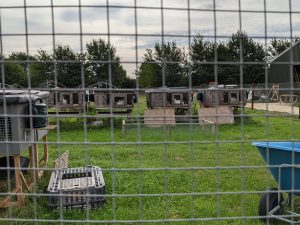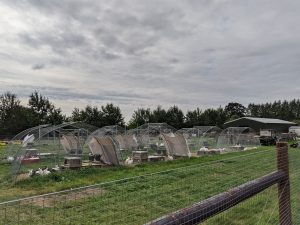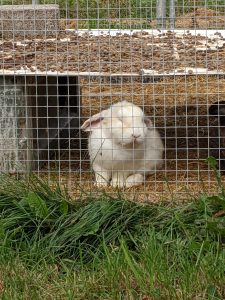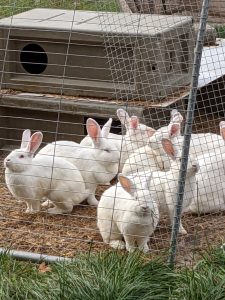Rabbits urgently need your help yet again!
T&S have put in another application at one of their sites – Land North West Of Lammas Farm, Kneeton Road, East Bridgford, Nottinghamshire, NG13 8PJ – for another of their cruel, unnecessary and inadequate farms – including a slaughterhouse.
Alarmingly, as is the case at Atlow and Rutland, multiple rabbits are already being kept here in Kerry’s vile “free range” system – as you can see in the below images.




The deadline to object by was the 18th of September, however this has been extended indefinitely – so please take the time to register your objection with Rushcliffe Borough Council via this link (please do read everything in our blog post for tips on what to write before you click this link, to make sure your objection will be considered): https://planningon-line.rushcliffe.gov.uk/online-applications/applicationDetails.do?activeTab=makeComment&keyVal=QWZPYONLGF700
Alternatively, email them on planningandgrowth@rushcliffe.gov.uk – Please remember to include the planning application reference number 21/02208/FUL along with your full name and address in order for it to be valid. You have the right to request that your personal details be kept anonymous and not published on the planning portal if you wish.
We have written out some useful points for you to expand upon in your own words below – please note that making your own statement rather than copy and pasting will have the best effect.
Please keep in mind that unfortunately, moral objections do not carry any weight in planning applications; however that doesn’t mean you shouldn’t voice your moral concerns alongside any ‘valid planning considerations’. Ask for welfare to be made a material consideration during the review of planning applications involving animals – particularly in the case of rabbit farms as there is no species-specific legislation protecting the welfare of rabbits in the UK, on farm or at slaughter.
Many points made against previous applications apply to this one – you will find these on the previous posts on our page. This application is identical to what has been applied for at the Atlow site.
– The proposed buildings contravene Local Plan Policy 22 – particularly points 6.13 and 6.22. Large unsightly farm and residential buildings are not in keeping with the surrounding area, which is largely undeveloped and on greenbelt land. These buildings would “unduly impact upon the character and appearance of the countryside.” Large unsightly ‘modern’ styled buildings are not in keeping with the surrounding area, which is largely undeveloped.
– The site is in a “Farm Wildlife Package Area” and is noted to be home to protected species such as Lapwings, and borders an area of National Forest. It is also in a higher level stewardship area whose main aims are wildlife conservation, maintenance and enhancement of landscape quality and character, Natural resource protection and Protection of the historic environment. Despite all this, there has been no ecological appraisal conducted in the application documents.
– Nothing in the application outlines how the waste produced by the farmed rabbits will be prevented from contaminating the area ie. how nearby water sources will be protected from waste run-off from the farm. The application states rabbit waste shall simply be left on the ground.
– Smells and traffic – rabbits create a lot of waste and ammonia, which will no doubt encroach on the surrounding area. Their bodies are to be disposed of via waste contractor lorries, another source of horrendous smells. The road on which the farm shall be accessed is already a busy route.
– No mention of how rabbits will be slaughtered, and no slaughterhouses hold a license to slaughter rabbits currently in the UK. There is no demand for rabbit meat in the UK, most people are repulsed at the thought of consuming it. As rabbit farming is something which is highly frowned upon in current public attitudes, the farm and slaughterhouse would attract protests and unwanted attention, disrupting and upsetting visitors to the area.
– If slaughtered on-site, as the planned “skinning/intake room” (aka. slaughterhouse) suggests the rabbit meat will only be allowed by law to be sold within Nottinghamshire and the adjoining counties (or no further than 50 kilometres from Nottinghamshire’s border)
– How many rabbits do they expect to farm/kill yearly? If more than 10,000 a year it will contravene government regulations – so this needs close monitoring.
– In the application form, the question “Does the proposal involve the need to dispose of trade effluents or trade waste?” is answered as “no” – yet the slaughter process again creates a great deal of waste, such as blood and offal, much of which is foul-smelling – yet there is nothing in the proposal to outline how this waste will be dealt with and prevented from contaminating the local area. How will the waste ie. carcasses, blood and offal be disposed of – this is not outlined anywhere in the planning application and it presents a contamination risk to the area in terms of it entering the surrounding environment and creating foul odours, so disposal methods should be clearly outlined in the plans.
– There’s also the question whether ‘agricultural use’ can really stretch to include slaughtering.
– The production cap of 10,000 rabbits per year, for ‘small-scale suppliers’ means the applicant is exempt from the Food Standards Agency (FSA) rules for monitoring and reporting. Without FSA oversight with the presence of an Official Vet (OV) and CCTV monitoring in all areas where animals are present, there would be no day-to-day oversight of animal welfare, meat hygiene, food safety or safe waste disposal.
– There has been huge public outcry regarding recent proposals for rabbit farms – tens of thousands have sent objections, signed petitions and attended demonstrations against them.
– There is no species-specific legislation in place to guarantee even minimum enforceable welfare standards for rabbits.
– There is a question of whether these farms are an attempt at fur farming ‘through the back door’ – the T&S website mainly advertises highly priced fur products which appear to generate the vast majority of their income. A recent yougov poll revealed that the vast majority (93%) of people in Britain don’t wear real animal fur and support a Fur Free Britain.
– There are no measures outlined on how they intend to combat the spread of disease in the rabbits. There are no specific drugs licensed for use in rabbits in the UK, due in large to the lack of commercial rabbit farming here. There is also no mention of vaccinating the rabbits against the fatal, incurable diseases Myxomatosis, VHD and VHD2. There have been documented outbreaks of VHD2 on Mr. Kerry’s other farms.
– There is a real concern that this proposal is all just a back door approach to get planning permission on this greenbelt site for it to be built upon. The area is very much undeveloped with no nearby houses, and locals believe this will lead to more of the beautiful countryside surrounding the area being destroyed for development.
– The location has been noted to be on a dangerous, narrow and busy road by local residents, which will be negatively impacted by an increase in traffic ie. from food delivery and waste disposal wagons. The approaching road is single track and has no markings, making it unfit for commercial traffic. The entrance to the land is also located very close to a junction, adding danger.
– The scale of the proposed development would have an adverse impact on the character and appearance of this tranquil rural area.
– It is becoming more and more challenging for this site to be reverted back to its original state and purpose, a wildlife haven and rich pasture land.
– Question why a modern three-bedroomed house claimed to be suitable for 5 occupants is required for the single worker who is needed to live on site. The application states no further employees will be taken on as a result of this proposal.
